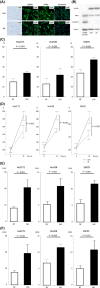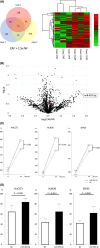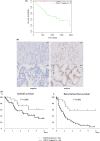Cancer-associated fibroblasts promote tumor cell growth via miR-493-5p in intrahepatic cholangiocarcinoma
- PMID: 36369960
- PMCID: PMC9986089
- DOI: 10.1111/cas.15644
Cancer-associated fibroblasts promote tumor cell growth via miR-493-5p in intrahepatic cholangiocarcinoma
Abstract
The association between tumor microenvironment (TME) and cancer-associated fibroblasts (CAFs) in intrahepatic cholangiocarcinoma (ICC) progression is poorly understood. This study aimed to reveal whether specific microRNAs (miRNAs) in extracellular vesicles (EVs) derived from CAFs were involved in ICC progression. Conditioned medium (CM) and EVs in the CM of CAFs and normal fibroblasts (NFs) derived from ICC specimens were used to investigate the effects on tumor cell lines. miRNA microarray assay was used to examine the miRNAs of EVs derived from CAFs and NFs in ICC, and the effects of miR-493-5p on tumor cell lines were examined. Additionally, databases were used to identify miR-493-5p targets, and the relationship between prognosis of ICC patients and cocaine- and amphetamine-regulated transcript propeptide (CARTPT), one of the targets of miR-493-5p, expression in ICC tissues was retrospectively analyzed. Compared with NF-derived CM and EVs, CAF-derived CM and EVs promoted cell lines in proliferation, scratch, migration, and invasion assays. miRNA microarray analysis revealed that miR-493-5p was significantly increased in CAF-derived EVs compared to NF-derived EVs. Tumor cell lines transfected with miR-493-5p were promoted in proliferation and scratch assays. Immunohistochemical staining was performed on 76 ICC specimens; both overall and recurrence-free survival rates were significantly worse in the CARTPT-negative group. Univariate and multivariate analyses showed that low CARTPT expression was an independent poor prognostic factor for overall and recurrence-free survival. Overall, our data suggest that CAFs in the ICC TME suppress CARTPT in tumor cells and promote tumor cells via miR-493-5p in EVs.
Keywords: cancer-associated fibroblast; extracellular vesicle; intrahepatic cholangiocarcinoma; microRNA; tumor microenvironment.
© 2022 The Authors. Cancer Science published by John Wiley & Sons Australia, Ltd on behalf of Japanese Cancer Association.
Conflict of interest statement
Y.O. is an Editorial Board Member of
Figures




Similar articles
-
CAFs shape myeloid-derived suppressor cells to promote stemness of intrahepatic cholangiocarcinoma through 5-lipoxygenase.Hepatology. 2022 Jan;75(1):28-42. doi: 10.1002/hep.32099. Epub 2021 Dec 5. Hepatology. 2022. PMID: 34387870
-
Extracellular vesicles-encapsulated microRNA-10a-5p shed from cancer-associated fibroblast facilitates cervical squamous cell carcinoma cell angiogenesis and tumorigenicity via Hedgehog signaling pathway.Cancer Gene Ther. 2021 May;28(5):529-542. doi: 10.1038/s41417-020-00238-9. Epub 2020 Nov 24. Cancer Gene Ther. 2021. PMID: 33235271
-
Cancer-associated fibroblasts derived extracellular vesicles promote angiogenesis of colorectal adenocarcinoma cells through miR-135b-5p/FOXO1 axis.Cancer Biol Ther. 2022 Dec 31;23(1):76-88. doi: 10.1080/15384047.2021.2017222. Cancer Biol Ther. 2022. PMID: 35100092 Free PMC article.
-
The role of Tripartite motif containing 59 (TRIM59) in the proliferation and prognosis of intrahepatic cholangiocarcinoma.Pathol Res Pract. 2022 Aug;236:153989. doi: 10.1016/j.prp.2022.153989. Epub 2022 Jun 17. Pathol Res Pract. 2022. PMID: 35753134 Review.
-
Cancer-Associated Fibroblasts in Hepatocellular Carcinoma and Cholangiocarcinoma.Cell Mol Gastroenterol Hepatol. 2023;15(4):985-999. doi: 10.1016/j.jcmgh.2023.01.006. Epub 2023 Jan 25. Cell Mol Gastroenterol Hepatol. 2023. PMID: 36708970 Free PMC article. Review.
Cited by
-
The Association of Transferrin Receptor with Prognosis and Biologic Role in Intrahepatic Cholangiocarcinoma.Ann Surg Oncol. 2024 Dec;31(13):8627-8637. doi: 10.1245/s10434-024-16065-3. Epub 2024 Aug 23. Ann Surg Oncol. 2024. PMID: 39179864
-
Tertiary lymphoid structures predict the prognosis and immunotherapy response of cholangiocarcinoma.Front Immunol. 2023 May 10;14:1166497. doi: 10.3389/fimmu.2023.1166497. eCollection 2023. Front Immunol. 2023. PMID: 37234171 Free PMC article.
-
Cancer therapy resistance mediated by cancer-associated fibroblast-derived extracellular vesicles: biological mechanisms to clinical significance and implications.Mol Cancer. 2024 Sep 7;23(1):191. doi: 10.1186/s12943-024-02106-8. Mol Cancer. 2024. PMID: 39244548 Free PMC article. Review.
-
The role of extracellular vesicles in cholangiocarcinoma tumor microenvironment.Front Pharmacol. 2024 Jan 10;14:1336685. doi: 10.3389/fphar.2023.1336685. eCollection 2023. Front Pharmacol. 2024. PMID: 38269274 Free PMC article. Review.
-
Transferrin Receptor is Associated with Sensitivity to Ferroptosis Inducers in Hepatocellular Carcinoma.Ann Surg Oncol. 2023 Dec;30(13):8675-8689. doi: 10.1245/s10434-023-14053-7. Epub 2023 Aug 7. Ann Surg Oncol. 2023. PMID: 37548836
References
-
- Burak K, Angulo P, Pasha TM, Egan K, Petz J, Lindor KD. Incidence and risk factors for cholangiocarcinoma in primary sclerosing cholangitis. Am J Gastroenterol. 2004;99:523‐526. - PubMed
-
- Mavros MN, Economopoulos KP, Alexiou VG, Pawlik TM. Treatment and prognosis for patients with intrahepatic cholangiocarcinoma: systematic review and meta‐analysis. Jama Surg. 2014;149:565‐574. - PubMed
MeSH terms
Substances
Grants and funding
LinkOut - more resources
Full Text Sources
Medical

